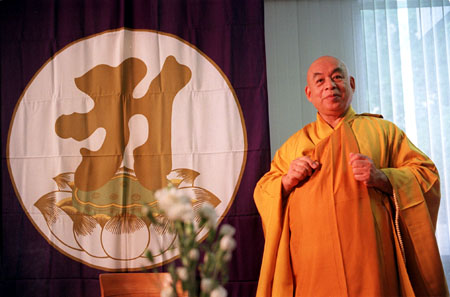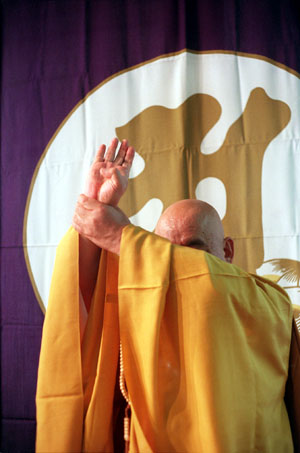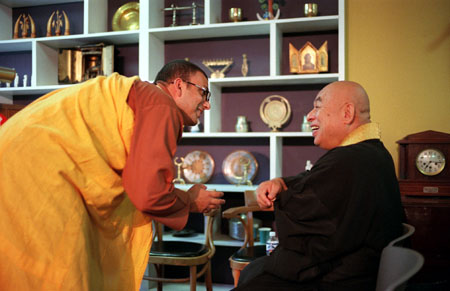Wisdom shines through
Buddhist bishop tells the tale of ancient fire rite

The mystical came to Harvard on Friday, Sept. 28, as Bishop Ekan Ikeguchi, master of the Japanese tradition of Shingon Buddhism, spoke about the Goma fire ritual in Japanese esoteric Buddhism. Although the only fire at the lunchtime event was from a match to light incense, Ikeguchi gave a demonstration that illustrated the power of the ritual.

Sponsored by the Harvard Buddhist Studies Forum in conjunction with the Harvard University Asia Center, Ikeguchi’s talk packed the common room of the Center for the Study of World Religions. Ikeguchi, the abbot of a major temple in southern Japan, is a high-ranking master in Shingon esoteric Buddhism and a healer with extensive medical training. “But he is most famous for his performance of this particularly elaborate version of the fire ritual,” said Robert Gimelli, visiting professor of East Asian Studies and Religious Studies, who introduced Ikeguchi.
Before discussing the specifics of the Goma ritual, in which up to 8,000 prayer sticks are burned, Ikeguchi discussed the origins and principles of Buddhism, often drawing parallels to Christian stories and traditions. He talked about Kobo Daishi Kukai, the founder of Shingon esoteric Buddhism, which has been practiced in Japan for about 1,200 years. Through mystical experiences like the Goma fire ritual, practitioners of the Shingon tradition “become” the Buddha to alleviate the suffering of those around them.
Within the Goma are two types of rituals, Ikeguchi explained through an interpreter. In the Sotogoma, which Ikeguchi has practiced 86 times, actual fire is burned after several weeks of fasting. “In the Uchigoma method, people pretend to burn the wisdom of fire within their hearts in order to eliminate the confusion and become being, serene and pure,” he said. “I try to invite the Buddha and make myself a Buddha by lighting the fire in my dark inside and separating the wisdom from the confusion completely.”
After changing from formal black robes into brilliant yellow ones, Ikeguchi performed the Uchigoma. In the fifteen-minute ritual, the master sat at a table arrayed with incense, bells, and brass bowls holding leaves and water. He alternately lifted, waved, and poured these bowls and made a series of hand gestures, called mudras. “This is what I do every day to be closer to Buddha,” Ikeguchi said. He demonstrated one of the hand movements, the opening of a lotus flower, explaining its significance.
Ikeguchi might have demonstrated more mudras had he not been hurried off to Logan Airport; he was scheduled to perform a ceremony at the World Trade Center site later that day. Before leaving, he admitted that “this was my first time at Harvard and I was very nervous. In fact, I forgot one thing from the beginning, but oh well.”
Share this article





